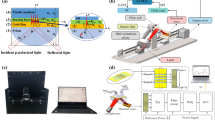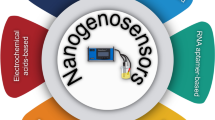Abstract
Majority of protocols for quantitative analysis of biomarkers (including nucleic acids) require calibrations and target standards. In this work, we developed a principle for quantitative analysis that eliminates the need for a standard of a target molecule. The approach is based on stoichiometric reporting. While stoichiometry is a simple and robust analytical platform, its utility toward the analysis of biomolecules is very limited due to the lack of general methodologies for detecting the equivalence point. In this work, we engineer a new target/probe-binding model that enables detecting the equivalence point while maintaining an appropriate level of specificity. We establish the probe design principles through theoretical simulations and experimental confirmation. Further, we demonstrate the utility of the stoichiometric analysis via a proof-of-concept system based on oligonucleotide hybridization. Overall, the approach that requires neither standard nor calibration yields quantitative results with an adequate accuracy (> 90–110%) and a high specificity. The principles established in our work are very general and can extend beyond oligonucleotide targets toward quantitative analysis of many other biomolecules such as antibodies and proteins.
Graphical abstract





Similar content being viewed by others
Availability of data and materials
All data generated and/or analyzed during this study are included in the article and supplementary information.
Code availability
Not applicable.
References
[[1]Atkinson AJ, Colburn WA, DeGruttola VG, DeMets DL, Downing GJ, Hoth DF, Oates JA, Peck CC, Schooley RT, Spilker BA, Woodcock J, Zeger SL. Biomarkers and surrogate endpoints: preferred definitions and conceptual framework. Clin. Pharmacol. Ther 2001; 69: 89–95. https://doi.org/10.1067/mcp.2000.113989
Gubala V, Harris LF, Ricco AJ, Tan MX, Williams DE. Point of care diagnostics: status and future. Anal Chem. 2012;84:487–515. https://doi.org/10.1021/ac2030199.
Wang LX, Ji CJ. Advances in quantitative bioanalysis of oligonucleotide biomarkers and therapeutics. Bioanalysis. 2016;8:143–55. https://doi.org/10.4155/bio.15.234.
Khodakov D, Wang C, Zhang DY. Diagnostics based on nucleic acid sequence variant profiling: Pcr, hybridization, and ngs approaches. Adv Drug Delivery Rev. 2016;105:3–19. https://doi.org/10.1016/j.addr.2016.04.005.
Kessler HH, Preininger S, Stelzl E, Daghofer E, Santner BI, Marth E, Lackner H, Stauber RE. Identification of different states of hepatitis b virus infection with a quantitative pcr assay. Clin Diagn Lab Immunol. 2000;7:298–300. https://doi.org/10.1128/cdli.7.2.298-300.2000.
Yang S, Rothman RE. Pcr-based diagnostics for infectious diseases: uses, limitations, and future applications in acute-care settings. Lancet Infect Dis. 2004;4:337–48. https://doi.org/10.1016/s1473-3099(04)01044-8.
Kawaguchi T, Komatsu S, Ichikawa D, Morimura R, Tsujiura M, Konishi H, Takeshita H, Nagata H, Arita T, Hirajima S, Shiozaki A, Ikoma H, Okamoto K, Ochiai T, Taniguchi H, Otsuji E. Clinical impact of circulating mir-221 in plasma of patients with pancreatic cancer. Br J Cancer. 2013;108:361–9. https://doi.org/10.1038/bjc.2012.546.
Rousseau F, Heitz D, Biancalana V, Blumenfeld S, Kretz C, Boué J, Tommerup N, Vanderhagen C, DeLozier-Blanchet C, Croquette MF, Gilgenkrantz S, Jalbert P, Voelckel MA, Oberlé I, Mandel JL. Direct diagnosis by DNA analysis of the fragile x-syndrome of mental-retardation. N Engl J Med. 1991;325:1673–81. https://doi.org/10.1056/nejm199112123252401.
Lemna WK, Feldman GL, Kerem BS, Fernbach SD, Zevkovich EP, O’Brien WE, Riordan JR, Collins FS, Tsui LC, Beaudet AL. Mutation analysis for heterozygote detection and the prenatal-diagnosis of cystic-fibrosis. N Engl J Med. 1990;322:291–6. https://doi.org/10.1056/nejm199002013220503.
Mohan R, Mach KE, Bercovici M, Pan Y, Dhulipala L, Wong PK, Liao JC. Clinical validation of integrated nucleic acid and protein detection on an electrochemical biosensor array for urinary tract infection diagnosis. PLoS ONE. 2011;6: e26846. https://doi.org/10.1371/journal.pone.0026846.
Hirajima S, Komatsu S, Ichikawa D, Takeshita H, Konishi H, Shiozaki A, Morimura R, Tsujiura M, Nagata H, Kawaguchi T, Arita T, Kubota T, Fujiwara H, Okamoto K, Otsuji E. Clinical impact of circulating mir-18a in plasma of patients with oesophageal squamous cell carcinoma. Br J Cancer. 2013;108:1822–9. https://doi.org/10.1038/bjc.2013.148.
Durner J. Clinical chemistry: Challenges for analytical chemistry and the nanosciences from medicine. Angew. Chem., Int. Ed. 2010; 49: 1026–1051. https://doi.org/10.1002/anie.200903363
Bellassai N, Spoto G. Biosensors for liquid biopsy: Circulating nucleic acids to diagnose and treat cancer. Anal Bioanal Chem. 2016;408:7255–64. https://doi.org/10.1007/s00216-016-9806-3.
Kalman TZ, Khalandovsky R, Tenenbaum Gonikman E, Bercovici M. Monitoring dissociation kinetics during electrophoretic focusing to enable high‐specificity nucleic acid detection. Angew. Chem., Int. Ed. 2018; 57: 3343–3348. doi:https://doi.org/10.1002/anie.201711673
Schwarzenbach H. Circulating nucleic acids as biomarkers in breast cancer. Breast Cancer Res. 2013;15:211. https://doi.org/10.1186/bcr3446.
Tsai CT, Robinson PV, Cortez FD, Elma MLB, Seftel D, Pourmandi N, Pandori MW, Bertozzi CR. Antibody detection by agglutination-pcr (adap) enables early diagnosis of hiv infection by oral fluid analysis. Proc Natl Acad Sci U S A. 2018;115:1250–5. https://doi.org/10.1073/pnas.1711004115.
Ishii S, Segawa T, Okabe S. Simultaneous quantification of multiple food- and waterborne pathogens by use of microfluidic quantitative pcr. Appl Environ Microbiol. 2013;79:2891–8. https://doi.org/10.1128/aem.00205-13.
Donhauser SC, Niessner R, Seidel M. Sensitive quantification of escherichia coli o157:H7, salmonella enterica, and campylobacter jejuni by combining stopped polymerase chain reaction with chemiluminescence flow-through DNA microarray analysis. Anal Chem. 2011;83:3153–60. https://doi.org/10.1021/ac2002214.
Ramírez-Castillo FY, Loera-Muro A, Jacques M, Garneau P, Avelar-González FJ, Harel J, Guerrero-Barrera AL. Waterborne pathogens: detection methods and challenges. Pathogens. 2015;4:307–34. https://doi.org/10.3390/pathogens4020307.
Yamamoto Y. Pcr in diagnosis of infection: Detection of bacteria in cerebrospinal fluids. Clin Diagn Lab Immunol. 2002;9:508–14. https://doi.org/10.1128/cdli.9.3.508-514.2002.
Cankar K, Štebih D, Dreo T, Žel J, Gruden K. Critical points of DNA quantification by real-time pcr – effects of DNA extraction method and sample matrix on quantification of genetically modified organisms. BMC Biotechnol. 2006;6:37. https://doi.org/10.1186/1472-6750-6-37.
Dong JH, Ueda H. Elisa-type assays of trace biomarkers using microfluidic methods. Wiley Interdiscip. Rev.: Nanomed. Nanobiotechnol. 2017; 9: e1457. https://doi.org/10.1002/wnan.1457
Moelans CB, de Weger RA, Van der Wall E, van Diest PJ. Current technologies for her2 testing in breast cancer. Crit Rev Oncol Hematol. 2011;80:380–92. https://doi.org/10.1016/j.critrevonc.2010.12.005.
Schuster J, Funke SA. Methods for the specific detection and quantitation of amyloid-beta oligomers in cerebrospinal fluid. J Alzheimers Dis. 2016;53:53–67. https://doi.org/10.3233/jad-151029.
Call DR. Challenges and opportunities for pathogen detection using DNA microarrays. Crit Rev Microbiol. 2005;31:91–9. https://doi.org/10.1080/10408410590921736.
Gopinath SCB, Tang TH, Chen Y, Citartan M, Lakshmipriya T. Bacterial detection: from microscope to smartphone. Biosens Bioelectron. 2014;60:332–42. https://doi.org/10.1016/j.bios.2014.04.014.
Shen JW, Li YB, Gu HS, Xia F, Zuo XL. Recent development of sandwich assay based on the nanobiotechnologies for proteins, nucleic acids, small molecules, and ions. Chem Rev. 2014;114:7631–77. https://doi.org/10.1021/cr300248x.
Sharma S, Zapatero-Rodríguez J, Estrela P, O’Kennedy R. Point-of-care diagnostics in low resource settings: present status and future role of microfluidics. Biosensors. 2015;5:577–601. https://doi.org/10.3390/bios5030577.
Nayak S, Blumenfeld NR, Laksanasopin T, Sia SK. Point-of-care diagnostics: recent developments in a connected age. Anal Chem. 2017;89:102–23. https://doi.org/10.1021/acs.analchem.6b04630.
Page FG. The birth of titrimetry: William lewis and the analysis of america potaches. Bull Hist Chem. 2001;26:66–72.
Debnath M, Farace JM, Johnson KD, Nesterova IV. Quantitation without calibration: Response profile as an indicator of target amount. Anal Chem. 2018;90:7800–3. https://doi.org/10.1021/acs.analchem.8b02053.
Chevillet JR, Kang Q, Ruf IK, Briggs HA, Vojtech LN, Hughes SM, Cheng HH, Arroyo JD, Meredith EK, Gallichotte EN, Pogosova-Agadjanyan EL, Morrissey C, Stirewalt DL, Hladik F, Yu EY, Higano CS, Tewari M. Quantitative and stoichiometric analysis of the microrna content of exosomes. Proc Natl Acad Sci U S A. 2014;111:14888–93. https://doi.org/10.1073/pnas.1408301111.
Ha SH, Ferrell JE. Thresholds and ultrasensitivity from negative cooperativity. Science. 2016;352:990–3. https://doi.org/10.1126/science.aad5937.
Dillen A, Vandezande W, Daems D, Lammertyn J. Unraveling the effect of the aptamer complementary element on the performance of duplexed aptamers: a thermodynamic study. Anal Bioanal Chem. 2021;413:4739–50. https://doi.org/10.1007/s00216-021-03444-y.
Du Y, Dong S. Nucleic acid biosensors: recent advances and perspectives. Anal Chem. 2017;89:189–215. https://doi.org/10.1021/acs.analchem.6b04190.
Hunter CA, Anderson HL. What is cooperativity? Angew. Chem., Int. Ed. 2009; 48: 7488–7499. https://doi.org/10.1002/anie.200902490
Ferrell JE. Q&a: Cooperativity. J Biol. 2009;8:53. https://doi.org/10.1186/jbiol157.
Alvarado D, Klein DE, Lemmon MA. Structural basis for negative cooperativity in growth factor binding to an egf receptor. Cell. 2010;142:568–79. https://doi.org/10.1016/j.cell.2010.07.015.
Srinivasan B, Forouhar F, Shukla A, Sampangi C, Kulkarni S, Abashidze M, Seetharaman J, Lew S, Mao L, Acton TB, Xiao R, Everett JK, Montelione GT, Tong L, Balaram H. Allosteric regulation and substrate activation in cytosolic nucleotidase ii from legionella pneumophila. Febs J. 2014;281:1613–28. https://doi.org/10.1111/febs.12727.
Ricci F, Vallée-Bélisle A, Porchetta A, Plaxco KW. Rational design of allosteric inhibitors and activators using the population-shift model: in vitro validation and application to an artificial biosensor. J Am Chem Soc. 2012;134:15177–80. https://doi.org/10.1021/ja304672h.
Porchetta A, Vallée-Bélisle A, Plaxco KW, Ricci F. Allosterically tunable, DNA-based switches triggered by heavy metals. J Am Chem Soc. 2013;135:13238–41. https://doi.org/10.1021/ja404653q.
Zadeh JN, Steenberg CD, Bois JS, Wolfe BR, Pierce MB, Khan AR, Dirks RM, Pierce NA. Nupack: analysis and design of nucleic acid systems. J Comput Chem. 2011;32:170–3. https://doi.org/10.1002/jcc.21596.
Satterfield BC, West JAA, Caplan MR. Tentacle probes: eliminating false positives without sacrificing sensitivity. Nucleic Acids Res. 2007;35: e76. https://doi.org/10.1093/nar/gkm113.
Satterfield BC, Bartosiewicz M, West JAA, Caplan MR. Surpassing specificity limits of nucleic acid probes via cooperativity. J Mol Diagn. 2010;12:359–67. https://doi.org/10.2353/jmoldx.2010.090056.
Connelly RP, Verduzco C, Farnell S, Yishay T, Gerasimova YV. Toward a rational approach to design split g-quadruplex probes. ACS Chem Biol. 2019;14:2701–12. https://doi.org/10.1021/acschembio.9b00634.
Kikuchi N, Reed A, Gerasimova YV, Kolpashchikov DM. Split dapoxyl aptamer for sequence-selective analysis of nucleic acid sequence based amplification amplicons. Anal Chem. 2019;91:2667–71. https://doi.org/10.1021/acs.analchem.8b03964.
O’Flaherty K, Maguire J, Simpson JA, Fowkes FJI. Immunity as a predictor of anti-malarial treatment failure: a systematic review. Malar J. 2017;16:158. https://doi.org/10.1186/s12936-017-1815-y.
Cutts JC, Powell R, Agius PA, Beeson JG, Simpson JA, Fowkes FJI. Immunological markers of Plasmodium vivax exposure and immunity: a systematic review and meta-analysis. BMC Med. 2014;12:150. https://doi.org/10.1186/s12916-014-0150-1.
Fiorentini S, Marsico S, Becker PD, Iaria ML, Bruno R, Guzmán CA, Caruso A. Synthetic peptide at20 coupled to klh elicits antibodies against a conserved conformational epitope from a major functional area of the hiv-1 matrix protein p17. Vaccine. 2008;26:4758–65. https://doi.org/10.1016/j.vaccine.2008.06.082.
Acknowledgements
Research reported in this publication was supported by the National Institute of General Medical Sciences of the National Institutes of Health under Award Number R15GM135796.
Funding
The reported studies were supported by the National Institute of General Medical Sciences of the National Institutes of Health under Award Number R15GM135796.
Author information
Authors and Affiliations
Contributions
All of the authors participated in the methodology design, performed experiments, and analyzed and discussed the data. I.V. Nesterova produced an original idea of this work, designed the general experimental methodology, and supervised the project. All of the authors contributed to the discussion of this manuscript and its writing. All of the authors read and approved the manuscript.
Corresponding author
Ethics declarations
Ethics approval
Not applicable.
Conflict of interest
Authors report no conflicts of interest/competing interests.
Consent to participate
Not applicable.
Consent to publication
Not applicable.
Conflict of interest
The authors declare no competing interests.
Source of biological material
Not applicable.
Statement on animal welfare
Not applicable.
Additional information
Publisher's note
Springer Nature remains neutral with regard to jurisdictional claims in published maps and institutional affiliations.
Supplementary Information
Below is the link to the electronic supplementary material.
Rights and permissions
About this article
Cite this article
Adegbenro, A., Coleman, S. & Nesterova, I.V. Stoichiometric approach to quantitative analysis of biomolecules: the case of nucleic acids. Anal Bioanal Chem 414, 1587–1594 (2022). https://doi.org/10.1007/s00216-021-03781-y
Received:
Revised:
Accepted:
Published:
Issue Date:
DOI: https://doi.org/10.1007/s00216-021-03781-y




